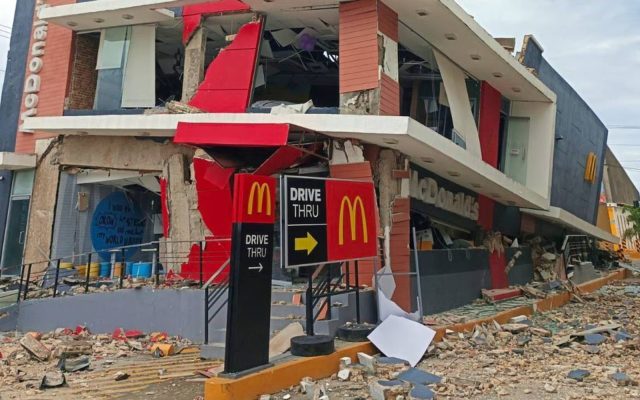MANILA, Philippines — A shallow 6.9-magnitude earthquake slammed the central Philippines late Tuesday, toppling buildings and killing at least 27 people on Cebu island, authorities said Wednesday. With rescuers combing through rubble in the darkness amid hundreds of aftershocks, officials feared the death toll could climb higher as they searched for survivors trapped under collapsed structures.
The quake struck at 9:50 p.m. local time (1:50 p.m. GMT) off the northern tip of Cebu near Bogo, a coastal city of about 90,000, according to the U.S. Geological Survey. Its shallow depth — just 10 kilometers (6 miles) underground — amplified the shaking, sending residents fleeing into the streets and triggering landslides that buried homes.
In Bogo, nine adults and four children perished, including three whose homes were swallowed by mudslides, local rescuers told The Associated Press. Five more deaths were reported in the nearby town of San Remigio, where a sports center’s roof caved in during a local basketball tournament, killing four people — including three coast guard members — as they played. A child was also crushed by falling debris elsewhere in San Remigio, officials said. One additional fatality was confirmed in Tabuelan, bringing the confirmed toll to 19.
“There could be people trapped beneath collapsed buildings,” said Wilson Ramos, a provincial rescue official, warning that the exact number of missing remained unknown as teams worked through the night in Bogo and San Remigio. Efforts were slowed by pitch-black conditions and relentless aftershocks — the Philippine Institute of Volcanology and Seismology tallied 379 by early Wednesday — forcing crews to pause repeatedly for safety.
Power outages plunged Cebu and surrounding central islands into darkness after lines snapped, but the National Grid Corp. of the Philippines restored electricity to Cebu and four major islands shortly after midnight. Village roads buckled in several spots, complicating access for emergency vehicles, while a commercial building and school in the nearby resort town of Bantayan fully collapsed. In Bogo, a fast-food restaurant was left in ruins.
Cebu Gov. Pamela Baricuatro, in a live video message on her official Facebook page, urged calm amid the chaos. “Stay calm and move to open areas; keep away from walls or structures that may collapse and stay alert for aftershocks,” she said. The provincial government issued an urgent call for medical volunteers on social media to bolster overwhelmed response teams.
Eyewitnesses described a terrifying jolt that left them frozen in fear. In San Fernando, firefighter Joey Leeguid recounted the station shaking violently. “We felt the shake here … it was so strong. We saw our locker moving from left to right, we felt slightly dizzy for a while but we are all fine now,” he told the AP.
Near the epicenter in Bantayan, 25-year-old Martham Pacilan was at the town square by a damaged church when the quake hit. “I heard a loud booming noise from the direction of the church then I saw rocks falling from the structure,” he said. “Luckily no one got hurt. I was in shock and in panic at the same time but my body couldn’t move, I was just there waiting for the shake to stop.”
Agnes Merza, a 65-year-old carer in Bantayan, said her kitchen tiles cracked as the ground heaved. “It felt as though we would all fall down. It’s the first time I have experienced it,” she told the AP. “The neighbors all ran out of their homes. My two teenage assistants hid under a table because that’s what they were taught in the Boy Scouts.”
The U.S. Geological Survey initially pegged the quake at 7.0 magnitude before revising it downward. The Pacific Tsunami Warning Center reported no tsunami risk.
Earthquakes rattle the Philippines almost daily as the archipelago straddles the Pacific “Ring of Fire,” a horseshoe-shaped zone of seismic and volcanic activity curving from Japan through Southeast Asia and across the Pacific. While most tremors are too faint to notice, powerful ones strike unpredictably, with no reliable way to forecast their timing or location. The archipelago has endured devastating quakes before, including a 2013 temblor on Bohol island that killed more than 200. (source: wire agencies, US Geological Survey, Philvolcs)














